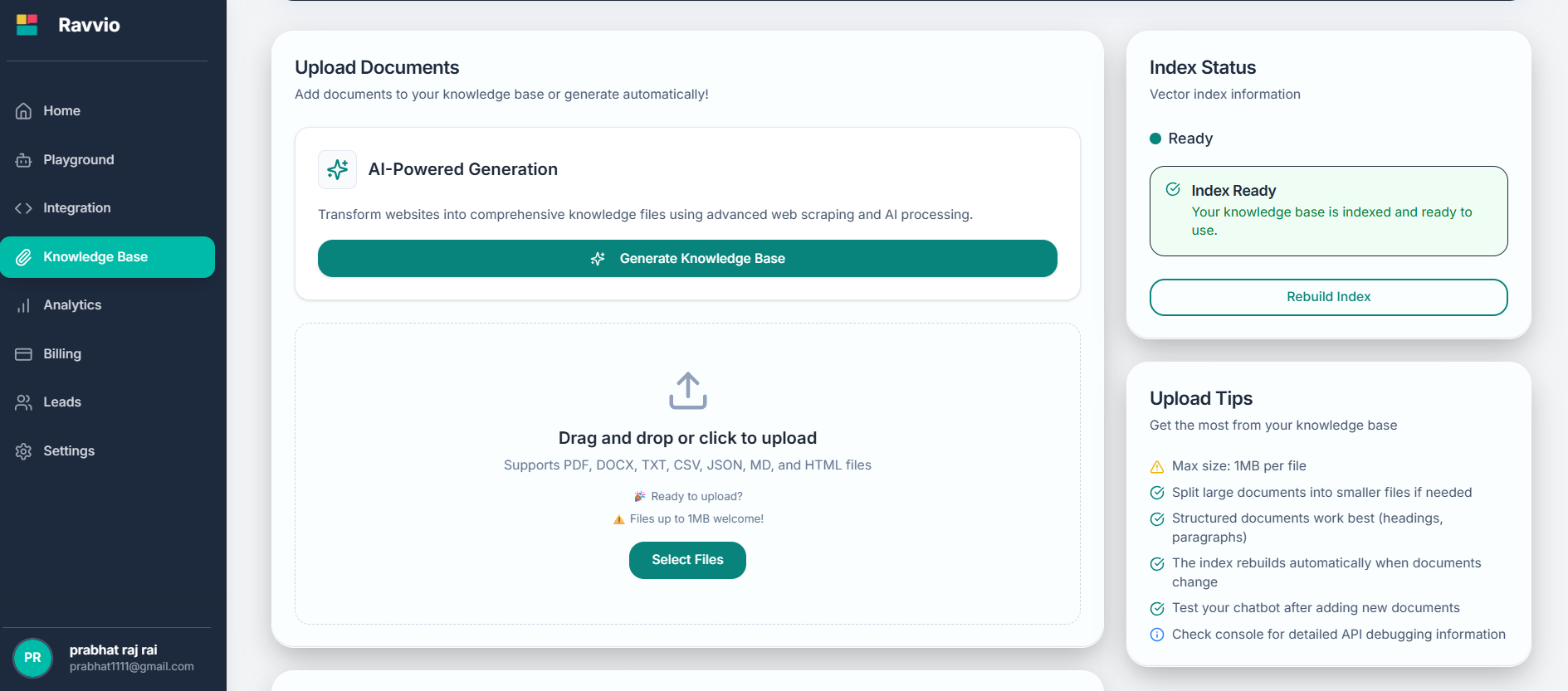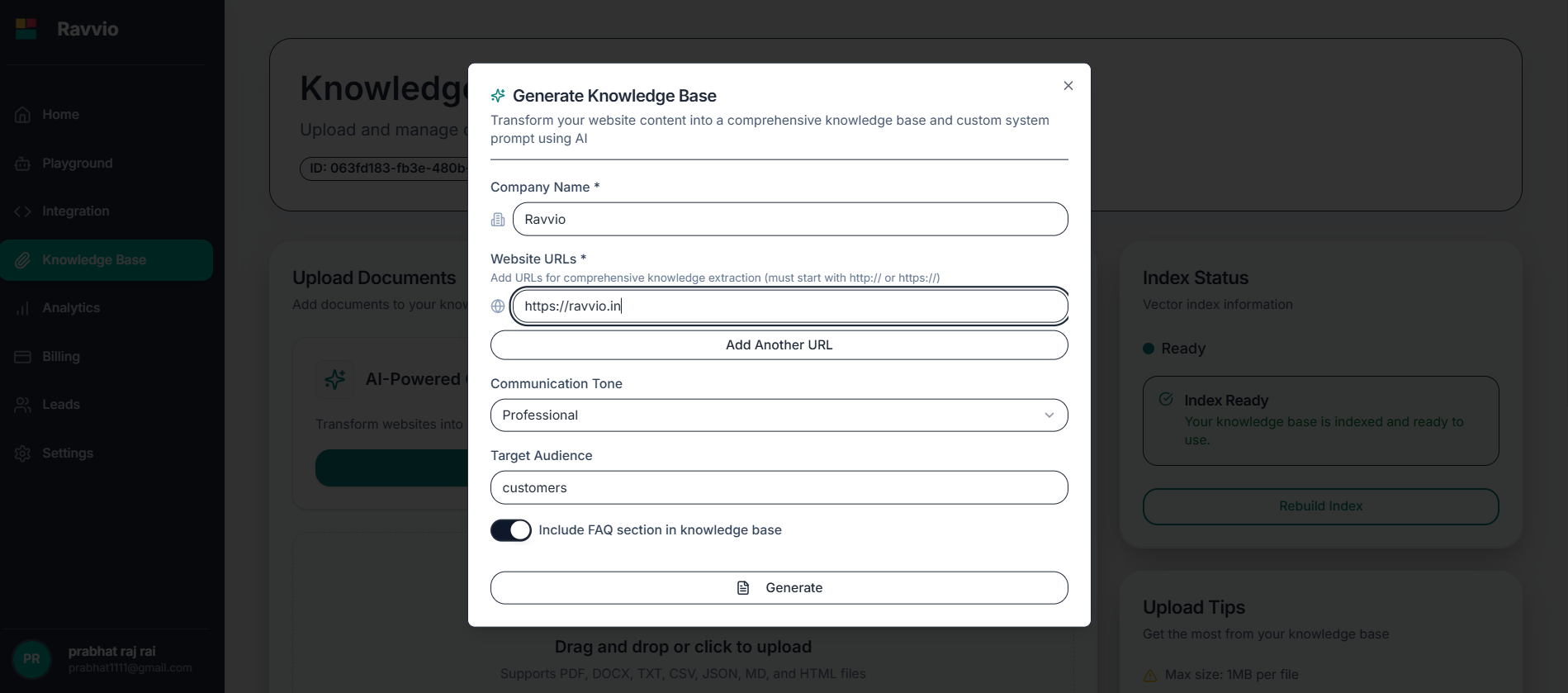Knowledge Base Overview
The knowledge base management system in Ravvio provides powerful tools to organize, maintain, and optimize your AI agent’s training content for maximum performance and accuracy.
Core Management Capabilities
Document Organization
Systematic organization and categorization of training materials
Processing Monitoring
Real-time tracking of document processing and indexing status
Content Optimization
Tools for improving knowledge base effectiveness and accuracy
Quality Control
Validation and verification of processed content quality
Document Management Interface
Document Library
Document Listing
Document Listing
Overview Display:
- Complete list of all uploaded documents
- File names, sizes, and upload dates
- Processing status indicators for each document
- Quick action buttons for individual documents
- Sort by name, date, size, or processing status
- Filter by document type or processing state
- Search functionality for quick document location
- Batch selection for multiple document operations
Document Details
Document Details
File Information:
- Original filename and file size
- Upload timestamp and user attribution
- Document type and format identification
- Processing completion status and timestamps
- Text extraction preview when available
- Document structure and organization insights
- Key topics and content themes identified
- Processing logs and any error notifications
Document Actions
Document Actions
Available Operations:
- View document processing details
- Reprocess documents if needed
- Download original files
- Remove documents from knowledge base
- Update document metadata and tags
Processing Status Tracking
1
Upload Confirmation
Document successfully received and queued for processing
2
Content Extraction
Text and data extraction from the uploaded document format
3
Content Analysis
Semantic analysis and topic identification within the document
4
Index Integration
Integration of processed content into searchable knowledge index
5
Ready for Use
Document content fully available for AI agent responses
Content Processing Features
Automatic Text Extraction

Multi-Format Support
Intelligent extraction from PDF, DOCX, TXT, CSV, JSON, MD, and HTML files
Structure Preservation
Maintains document hierarchy, headings, and organizational structure
Metadata Extraction
Captures titles, headers, and formatting information for context
Error Handling
Robust processing with error detection and recovery mechanisms
Intelligent Content Chunking
Semantic Segmentation
Semantic Segmentation
Smart Chunking Process:
- Content divided into logical, meaningful sections
- Preservation of context within each chunk
- Optimal chunk sizes for AI processing efficiency
- Maintenance of relationships between related sections
Context Preservation
Context Preservation
Relationship Management:
- Links between related document sections maintained
- Hierarchical structure preserved across chunks
- Cross-references and citations tracked
- Topic continuity ensured for accurate responses
Optimization Algorithms
Optimization Algorithms
Processing Enhancement:
- Dynamic chunk sizing based on content complexity
- Overlap strategies to prevent information loss
- Priority weighting for important content sections
- Performance optimization for query response speed
Semantic Indexing System
1
Content Analysis
Deep semantic analysis of document content and themes
2
Topic Identification
Automatic identification and categorization of key topics
3
Relationship Mapping
Creation of connections between related concepts and information
4
Search Optimization
Index optimization for fast and accurate information retrieval
5
Context Integration
Integration with existing knowledge base for enhanced accuracy
Index Health Monitoring
Status Indicators
Ready Status
Ready Status
Green Indicator:
- All documents successfully processed and indexed
- Content fully available for AI agent responses
- No processing errors or warnings
- Optimal performance and response accuracy
- Fast query response times
- High-quality answer generation
- Complete content accessibility
- System operating at full capacity
Building Status
Building Status
Yellow Indicator:
- Documents currently being processed
- Some content may be temporarily unavailable
- Processing queue active with pending documents
- Partial knowledge base functionality
- New uploads being integrated
- Temporary gaps in available information
- Gradual improvement as processing completes
- Normal system operation during updates
Error Status
Error Status
Red Indicator:
- Processing failures or system issues detected
- Some documents failed to process correctly
- Potential gaps in knowledge base coverage
- Immediate attention and resolution required
- Review error logs and messages
- Retry failed document processing
- Contact support for persistent issues
- Verify document formats and integrity
Performance Metrics
Processing Speed
Average time for document processing and index integration
Success Rate
Percentage of documents successfully processed without errors
Index Size
Total amount of processed content available for queries
Query Performance
Average response time for information retrieval requests
Content Quality Management
Quality Assurance Features
1
Content Validation
Automatic validation of extracted text quality and completeness
2
Duplicate Detection
Identification and handling of duplicate or redundant content
3
Relevance Assessment
Evaluation of content relevance and usefulness for agent responses
4
Accuracy Verification
Validation of processed content against original documents
5
Continuous Improvement
Ongoing optimization based on usage patterns and feedback
Content Optimization Tools
Relevance Scoring
Relevance Scoring
Automatic Assessment:
- Content scored based on relevance to your business domain
- Identification of high-value information for prioritization
- Detection of outdated or less useful content
- Recommendations for knowledge base improvements
Gap Analysis
Gap Analysis
Coverage Assessment:
- Identification of knowledge gaps in your content
- Analysis of frequently asked questions without answers
- Recommendations for additional content needs
- Topic coverage mapping and improvement suggestions
Performance Analytics
Performance Analytics
Usage Insights:
- Tracking of which content sections are most frequently accessed
- Analysis of successful vs. unsuccessful information retrieval
- Identification of content that improves response quality
- Data-driven recommendations for content optimization
Maintenance and Updates
Regular Maintenance Tasks
Content Review
Periodic review of document relevance and accuracy
Index Optimization
Regular optimization of search index for improved performance
Quality Assessment
Ongoing evaluation of content quality and usefulness
Performance Monitoring
Continuous monitoring of system performance and response quality
Update Management
Content Updates
Content Updates
Document Refresh Process:
- Replace outdated documents with current versions
- Automatic reprocessing of updated content
- Preservation of document relationships and references
- Seamless transition to updated information
Batch Operations
Batch Operations
Bulk Management:
- Multiple document upload and processing
- Batch removal of outdated content
- Mass updates to document metadata
- Bulk reprocessing for system improvements
Version Control
Version Control
Change Management:
- Tracking of document versions and updates
- Rollback capabilities for problematic changes
- Change logs and audit trails
- Impact assessment of content modifications
Troubleshooting and Support
Common Issues
Processing Failures
Processing Failures
Typical Causes:
- Corrupted or damaged document files
- Unsupported file formats or versions
- Documents exceeding size limitations
- Network interruptions during upload
- Verify file integrity and format compatibility
- Check file size against system limits
- Retry upload with stable internet connection
- Contact support for persistent processing issues
Search Performance Issues
Search Performance Issues
Potential Problems:
- Large knowledge base affecting response times
- Index fragmentation from frequent updates
- Overloaded system during peak usage
- Network latency affecting query performance
- Regular index maintenance and optimization
- Content pruning to remove outdated information
- Strategic document organization and chunking
- Performance monitoring and proactive maintenance
Support Resources
For technical issues with knowledge base management, contact support at [email protected] with detailed information about the problem and steps attempted.
- Description of the specific issue encountered
- Screenshots of error messages or status indicators
- List of affected documents or processing attempts
- Timeline of when the problem began
- Steps already taken to resolve the issue
